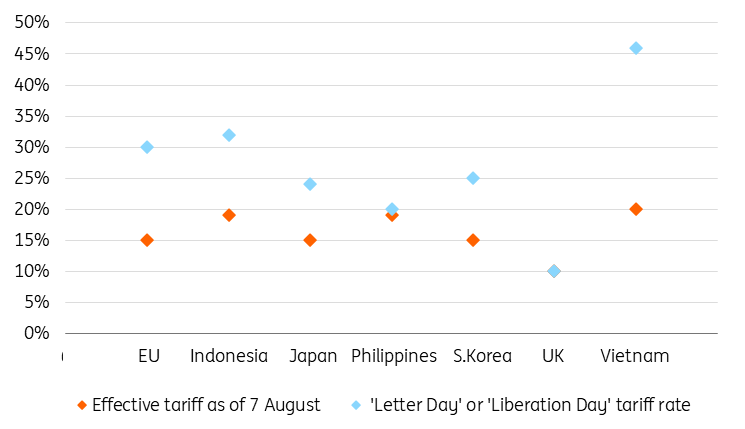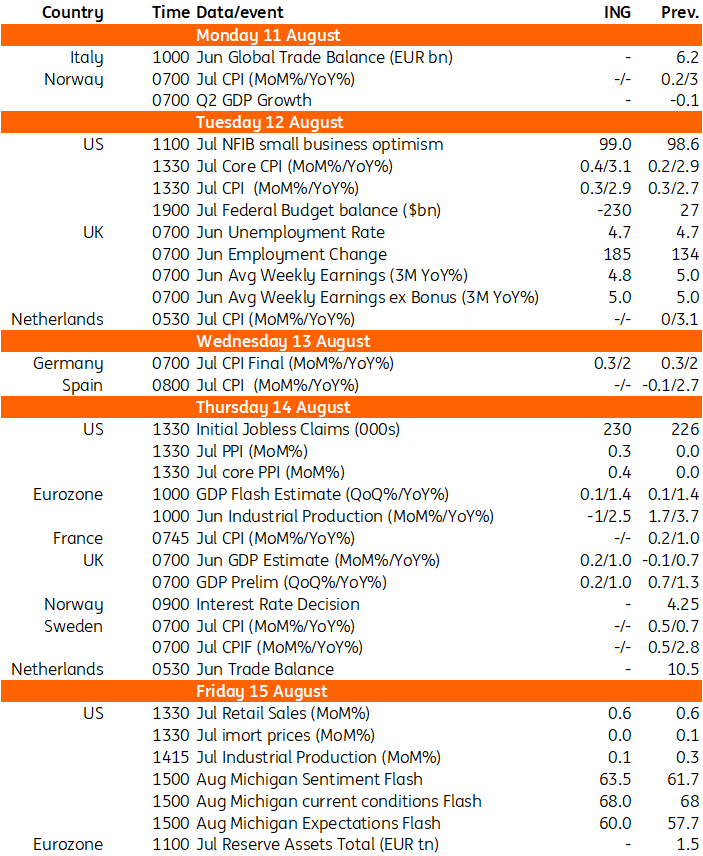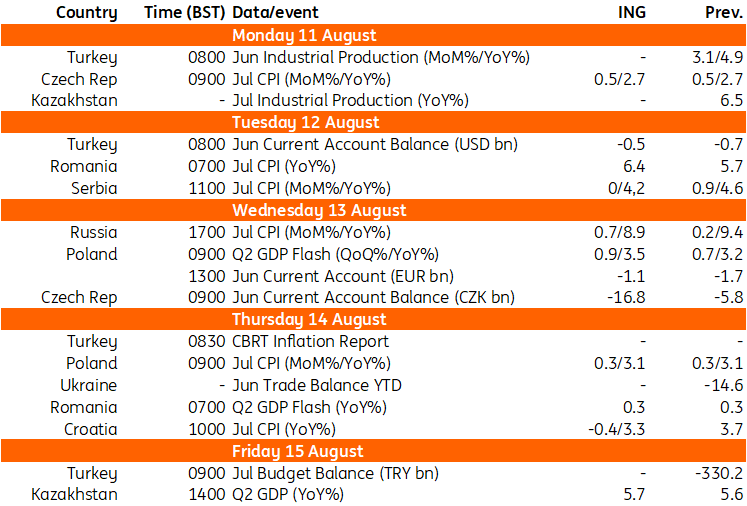After the Bank of England’s unprecedented split vote this week, James Smith asks: why can’t central banks just make their minds up on ? Interest rate expectations are set for a volatile ride, he argues, starting with Tuesday’s all-important US numbers. Here’s everything we’re looking for next week. Wasn’t summer supposed to be quiet?
Why Central Banks Can’t Agree
What do the UK and US economies have in common right now? Quite a lot, actually, when you think about it.
Both are likely to see inflation briefly rise to around 4% this year. Both have creaking jobs markets. Both have seen big revisions to the hiring numbers recently. And both have seen their growth outlooks sour amid mounting domestic policy uncertainty.
Why, then, are their respective central banks set to do wildly different things with interest rates this autumn? That’s the perception at least. Investors are pricing more than three US rate cuts by next easter, where barely one is priced in the UK.
Obviously, I’m simplifying things a bit. The UK isn’t waging a massive tariff war, nor is it installing known doves to its rate-setting committee.
Still, the stark differences between Federal Reserve and Bank of England expectations are hard to reconcile. One is likely to be wrong. And quite possibly both.
But how have we ended up in this situation? And why are there such unprecedented levels of disagreement among policymakers on the way forward? This week’s BoE decision yielded the first ever tied vote, while July’s Fed meeting saw two governors dissent for the first time in over 30 years.
I see three explanations:
One, now more than ever, it’s possible to reach wildly different interpretations from the economic data. In the UK, next week’s payroll data is likely to confirm that employment has fallen in eight out of the last nine months. Yet, redundancies haven’t risen at all. And surveys suggest hiring is essentially flat. The true picture is far from clear.
Data quality issues don’t help, a problem far from unique to the UK. Response rates to key surveys have fallen since Covid, and that’s partly why we’re seeing big revisions, like the shock downgrades to May/June’s US payrolls. Isolating trends is getting harder.
Secondly, there’s the supply side of the economy. It’s a woolly concept, admittedly. And it’s something policymakers didn’t have to worry about before the pandemic, when economies (Europe, particularly) weren’t exactly running at full capacity.
Since then, though, economies have been running hot. Supply chain disruption and worker shortages have taken on greater significance. But this stuff is hard to measure, so it’s no surprise there’s a range of views out there.
That said, there’s a growing acceptance that US immigration policy is putting limits on staffing availability. It’s why Chair Powell has said he is putting more weight on data like the unemployment rate, which theoretically does a better job of incorporating those supply constraints than payrolls.
Whether Powell still thinks that after July’s bombshell jobs numbers, time will tell. But unemployment has undoubtedly been more stable. So if you wanted to make an argument against a September rate cut – and there aren’t many right now – this is certainly one of them.
Another is inflation – the third source of active disagreement. Next (LON:) week’s US data is likely to be hot. James Knightley is expecting core CPI to come in at a punchy 0.4% month-on-month, which in annualised terms is consistent with almost 5% inflation. August’s data could be similar.
Now, there are very good reasons to think this tariff-driven spike won’t last, which James outlines below. I’d make similar arguments about the UK, which is ultimately why I still think the BoE will cut rates again in November, even if that call looks a shakier after this week’s meeting.
But the hawks at the Fed and BoE worry about a repeat of the infamous 2022 inflation spike. Officials in the UK have said that inflation is statistically more likely to become entrenched when headline reaches its current 3.5-4% level. The idea is that something changes in the psychology of households and businesses that makes inflation more likely to stick.
I’m not convinced, as I’ve explained before. But more importantly, I’m not sure the likes of the Fed or the BoE have the luxury of time to have these debates right now, given the omens emerging from the jobs market. What the UK and US – and many others, for that matter – have in common is the much longer lags involved with policy changes hitting the real economy. More prevalent fixed-rate lending has seen to that. The risk of falling behind the curve is real.
That means when the Fed does cut, it will probably do so quicker than many expect. We now think the Fed will cut rates in September, and a further four times by early 2026. That’s a more aggressive path than markets are pricing.
Still, my conclusion from everything I’ve said here – data uncertainty, changes to the Fed board, the inflation roller coaster – is that we’re in for a more volatile period of central bank expectations.
Every data point is taking on greater significance. There are two more inflation prints and one more jobs report before September’s Fed meeting, and each one will be a serious test of that market’s conviction in imminent rate cuts – even if that is probably the direction of travel.
Want to know more about that data and everything else to do with the Federal Reserve? Our webinar this coming Tuesday comes hot on the heels of those US inflation figures.
Chart of the Week: US Tariff Levels After Recent ’Trade Deals’

Source: The White House, ING
THINK Ahead in Developed Markets
United States
Inflation (Tues): We saw some early evidence of the tariff impact in the June report, with core goods prices excluding autos rising 0.6%MoM, the biggest monthly increase since February 2022. We expect to see a similarly sized index rise this time, with autos likely to also contribute to a faster rate of inflation.
Vehicle prices surprisingly fell last in June despite the exposure to major tariff increases, while increases in car auction prices also add upside risk for the July reading. Consequently, we are forecasting a 0.4%MoM increase in , above the 0.3% consensus forecast.
We don’t think the Fed should worry about a repeat of 2021/22 when a supply-side shock led to inflation hitting 9%. Services dominate the inflation basket by weighting, and here the situation is very different to 2021/22. Remember that tripled over that period, house prices and housing rents surged, while the jobs market was red hot with desperate hiring practices resulting in record employee turnover as wages soared.
This all helped to amplify and extend the post-Covid supply-shock-related increase in goods prices. Today, these are all disinflationary influences, with cooling housing rents in particular set to help offset the effect of tariffs over the coming quarters.
/University of Michigan (Fri): Decent auto sales volumes should lift the headline sales figures, but weak consumer confidence figures due to anxiety over tariff-induced price hikes, worries about the state of the jobs market and volatility in household wealth mean activity will likely slow through the second half of the year.
United Kingdom (TADAWUL:)
Jobs report (Tues): The BoE was remarkably relaxed about the jobs market in its August decision, despite payroll employment having fallen gradually for several months now. Do we see another dramatic drop in those hiring numbers this month? It’s possible, though. Remember, these have a tendency of being revised up later.
(Thur): Like everywhere else, the numbers have been skewed by a surge in exports in Q1 as firms sought to get ahead of US tariffs. Q2 has unsurprisingly been weaker, but on average, activity still likely rose through the spring.
THINK Ahead in Central and Eastern Europe
Poland
Flash 2Q25 GDP (Wed): Despite a decline in construction output and continued weakness in industrial production growth, preliminary data suggest that GDP growth accelerated in the second quarter. Annual GDP growth is estimated at 3.5% YoY, up from 3.2% YoY in 1Q25. A notable driver was retail sales of goods, which surged to nearly 6% YoY, compared to just 1.4% YoY in the previous quarter, pointing to stronger momentum in private consumption.
June Current Account (Wed): We estimate a €1.1bn deficit in the June current account, which widened the 12-month cumulative external imbalance slightly to -1.1% of GDP, from -1.0% in May. However, the annual trade deficit remained broadly stable at 1.6% of GDP. Our forecasts show exports in euro terms rose 0.8% YoY, while imports increased 3.2% YoY.
Despite the widening imbalance, the current account position remains manageable and is not expected to threaten macroeconomic stability or the outlook for the PLN.
July CPI (Thu): Final figures should confirm that headline inflation remained above 3% YoY in July, with core inflation still elevated. Although CPI dropped significantly from 4.1% YoY in June to 3.1% YoY, we believe this decline is not enough to justify a 50bps rate cut as previously anticipated. Instead, we now expect a more gradual easing path, starting with a 25bps cut in September, followed by similar moves in October and November, bringing the NBP’s main policy rate to 4.25% by year-end.
Romania
July CPI (Tue): Following June’s higher-than-expected print, we expect to learn that inflation picked up to 6.4% in July, mostly due to energy prices, which are set to rise after the end of the electricity subsidy scheme. On the economic activity front, we foresee an almost stagnating GDP growth (2nd quarter, flash release), in line with the relatively muted activity seen so far in high-frequency indicators.
Czech Republic
July CPI (Mon): July’s preliminary estimate of headline inflation is likely to be confirmed by the Statistical Office, while the breakdown will show potent core inflation. Meanwhile, softer food price dynamics mitigated the overall inflation figure. The current account deficit is expected to have widened in June.
Key Events In Developed Markets Next Week

Source: Refinitiv, ING
Key Events in EMEA Next Week

Source: Refinitiv, ING
Disclaimer: This publication has been prepared by ING solely for information purposes irrespective of a particular user’s means, financial situation or investment objectives. The information does not constitute investment recommendation, and nor is it investment, legal or tax advice or an offer or solicitation to purchase or sell any financial instrument. Read more

